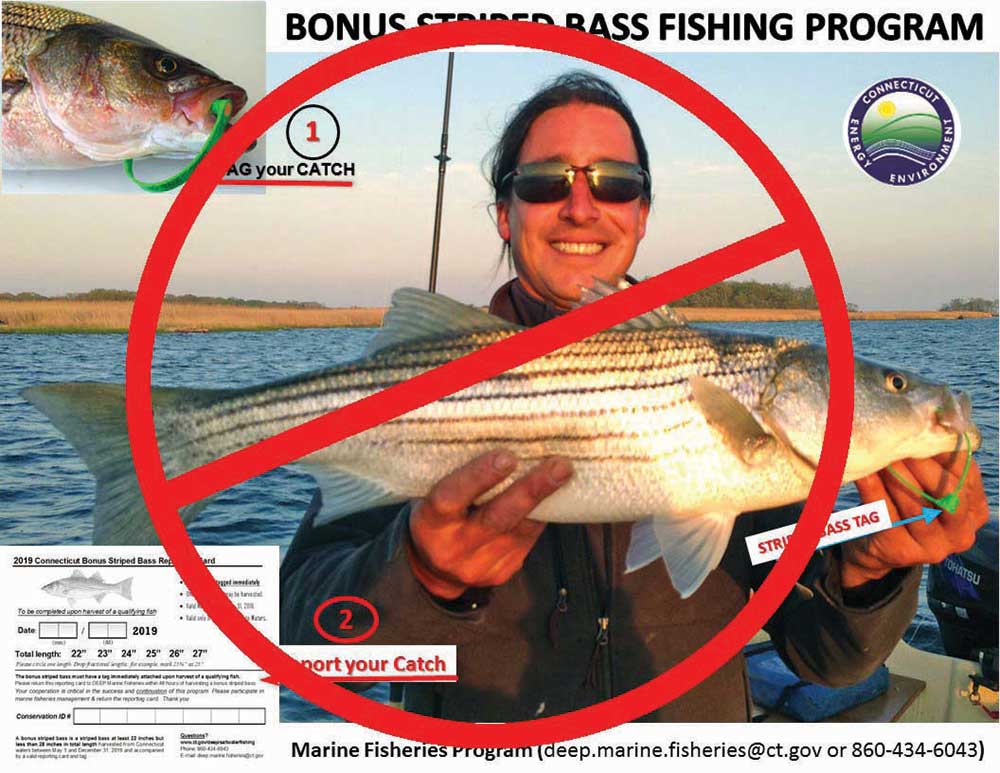The state of Connecticut was allocated 17,813 pounds of striped bass for commercial harvest as part of Addendum IV to the Striped Bass Fishery Management Plan in 2014. With no commercial striped bass fishery in Connecticut, the fish were transferred to the recreational sector in the form of 3,018 fish (size 22 to 28 inches) in 2019. Anglers who possessed a tag, which were available at six of the DEEP offices across the state, could then harvest one fish within the size range from either the marine or inland waters from May through December. Only one tag could be issued per license holder, and once the tag was used a card recording date of harvest and size of fish was to be returned to the DEEP.
On January 10, 2020, the Connecticut Bonus Striped Bass Program was put on hold, indefinitely, as follows.
BONUS STRIPED BASS PROGRAM DISCONTINUED
The Connecticut Department of Energy and Environmental Protection (Department) is suspending indefinitely the Bonus Striped Bass Program beginning in 2020. The 2018 ASMFC Atlantic Striped Bass Stock Assessment concluded that the stock is overfished and experiencing overfishing. As a result, Connecticut and other coastal states will be implementing measures in 2020 to reduce striped bass harvest. In light of the overfished condition of the coastal striped bass stock and the need to reduce harvest, the Department has decided to suspend the Bonus Striped Bass Program until the stock recovers. Low rates of program participation, as evidenced by low numbers of Striped Bass Bonus Program Voucher returns in recent years, also contributed to the Department’s decision to suspend the Striped Bass Bonus Program.
For further information, contact the DEEP Marine Fisheries Program by email at deep.marine.fisheries@ct.gov, by mail at P.O. Box 719, Old Lyme, CT 06371 or by telephone at 860.434.6043 between the hours of 8:30 AM and 4:30 PM, Monday through Friday.

The Connecticut Striped Bass Bonus Program has drawn criticism since its original inception in 2011. Opponents argued that even though there is no commercial striped bass fishery in Connecticut, a dead fish is a dead fish regardless of who harvests it (commercial or recreational), and transferring the quota as per this program simply serves to further the divide between the two groups. Additionally, by allowing anglers to legally harvest a striped bass between 22 and 28 inches, it opened up an opportunity for unscrupulous anglers to attempt to abuse the system. For better or worse, many of the opponents to the program would claim a tag, fail to use it and essentially “protect” that fish, which would have otherwise been harvested under the program.
Supporters of the program argued that it provided a way for anglers who might not otherwise have an opportunity to harvest a striped bass annually the chance to do so. It also had the goal of enhancing urban and shore-based fishing where landing a “keeper” can be difficult. When the program was initiated it only included waters of the Connecticut River as an attempt to help protect the diminishing numbers of river herring found there as it was theorized that the increased numbers of striped bass being seen in the river at the time contributed to the herring decline. Regardless of which side of the fence you fall, the point is moot for the time being.




